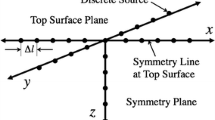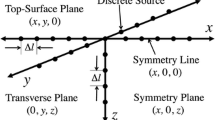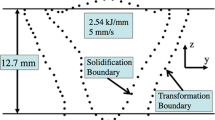Abstract
Case study inverse thermal analyses of Vanadium and Tantalum laser welds are presented. These analyses employ a methodology that is in terms of analytic basis functions for inverse thermal analysis of steady-state energy deposition in plate structures. The results of the case studies presented provide parametric representations of weld temperature histories that can be adopted as input data to various types of computational procedures, such as those for prediction of solid-state phase transformations. In addition, these temperature histories can be used to construct parametric-function representations for inverse thermal analysis of welds corresponding to other process parameters or welding processes process conditions of which fall within similar regimes. This study also discusses specific aspects the inverse-analysis methodology relevant to further development of algorithms for its application in practice.





Similar content being viewed by others
References
R.W. Farebrother, Linear Least Square Computations, Marcel Dekker, New York, 1988
Y.B. Bard, Nonlinear Parameter Estimation, Academic Press, New York, 1974
K. Levenberg, A Method for the Solution of Certain Non-linear Problems in Least-Squares, Q. Appl. Math., 1944, 2, p 164–168
D.W. Marquardt, An Algorithm for Least Squares Estimation of Nonlinear Parameters, J. Soc. Ind. Appl. Math., 1963, 11, p 431–441
S. Mishra and T. DebRoy, Tailoring Gas Tungsten Arc Weld Geometry using a Genetic Algorithm and a Neural Network Trained with Convective Heat Flow Calculations, Mater. Sci. Eng. A, 2007, 454-455, p 477–486
A. Tarantola, Inverse Problem Theory and Methods for Model Parameter Estimation, SIAM, Philadelphia, PA, 2005
M.N. Ozisik and H.R.B. Orlande, Inverse Heat Transfer, Fundamentals and Applications, Taylor and Francis, New York, 2000
K. Kurpisz and A.J. Nowak, Inverse Thermal Problems, Computational Mechanics Publications, Boston, USA, 1995
O.M. Alifanov, Inverse Heat Transfer Problems, Springer, Berlin, 1994
J.V. Beck, B. Blackwell, and C.R. St, Clair, Inverse Heat Conduction: Ill-Posed Problems, Wiley, New York, 1985
J.V. Beck, Inverse Problems in Heat Transfer with Application to Solidification and Welding, Modeling of Casting, Welding and Advanced Solidification Processes V, M. Rappaz, M.R. Ozgu, and K.W. Mahin, Eds., The Minerals, Metals and Materials Society, 1991, p 427–437
J.V. Beck, Inverse Problems in Heat Transfer, Mathematics of Heat Transfer, G.E. Tupholme and A.S. Wood, Eds., Clarendon Press, 1998, p 13–24
S.G. Lambrakos, A.D. Zervaki, G.N. Haidemenopoulos, and V. Stergiou, Basis Functions and Parameterizations for Inverse Analysis of Welding Processes, Mathematical Modelling of Weld Phenomena, Vol. 9, H.H. Cerjak, Ed., Verlag der Technischen Universite Graz, Austria, 2011, p 793
A.D. Zervaki, G.N. Haidemenopoulos, and S.G. Lambrakos, Analysis of Heat Affected Zone using Direct and Inverse Modelling in 6XXX Aluminum Alloys, Mathematical Modelling of Weld Phenomena, Vol. 8, H.H. Cerjak, Ed., Verlag der Technischen Universite Graz, Austria, 2007, p 907
S.G. Lambrakos and S.G. Michopoulos, Algorithms for Inverse Analysis of Heat Deposition Processes, Mathematical Modelling of Weld Phenomena, Vol. 8, H.H. Cerjak, Ed., Verlag der Technischen Universite Graz, Austria, 2007, p 847
S.G. Lambrakos and J.O. Milewski, Analysis of Welding and Heat Deposition Processes using an Inverse-Problem Approach, Mathematical Modelling of Weld Phenomena, Vol. 7, H.H. Cerjak, Ed., Verlag der Technischen Universite Graz, Austria, 2005, p 1025–1055
J. Xie and J. Zou, Numerical Reconstruction of Heat Fluxes, SIAM J. Numer. Anal., 2005, 43(4), p 1504–1535
H.S. Carslaw and J.C. Jaegar, Conduction of Heat in Solids, 2nd ed., Clarendon Press, Oxford, 1959, p 374
T.A. Palmer, B. Wood, J.W. Elmer, C. Westrich, J.O. Milewski, M. Piltch, and R. Carpenter: Characterization of Stainless Steel and Refractory Metal Welds Made Using a Diode-Pumped, Continuous Wave Nd:YAG Laser, Report UCRL-ID-146005, Lawrence Livermore.
Acknowledgment
This study was supported by a Naval Research Laboratory (NRL) internal core program.
Author information
Authors and Affiliations
Corresponding author
Rights and permissions
About this article
Cite this article
Lambrakos, S.G. Inverse Thermal Analysis of Refractory Metal Laser Welds. J. of Materi Eng and Perform 22, 2467–2476 (2013). https://doi.org/10.1007/s11665-013-0571-6
Received:
Revised:
Published:
Issue Date:
DOI: https://doi.org/10.1007/s11665-013-0571-6




